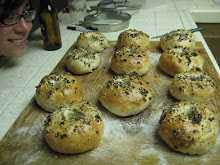 One of the first more advanced breads I attempted once I realized I was serious about this whole bread baking hobby is Peter Reinhart's poolish focaccia from the Bread Baker's Apprentice. I made it well before I had the book though. I found the recipe here, along with very thorough and helpful pictures and instructions. At first I was aghast at the amount of olive oil in this recipe, but it is absolutely delicious and anything less would leave it dry. Don't skimp on the olive oil! It's heart healthy!
One of the first more advanced breads I attempted once I realized I was serious about this whole bread baking hobby is Peter Reinhart's poolish focaccia from the Bread Baker's Apprentice. I made it well before I had the book though. I found the recipe here, along with very thorough and helpful pictures and instructions. At first I was aghast at the amount of olive oil in this recipe, but it is absolutely delicious and anything less would leave it dry. Don't skimp on the olive oil! It's heart healthy! I enjoyed this recipe so much that I went out and bought the book, which is the #1 book I recommend if you enjoy making bread. It is a testament to the quality of the book that many of the pages are stuck together with dough, stained with butter or oil, or are otherwise soiled from use on the counter.
I enjoyed this recipe so much that I went out and bought the book, which is the #1 book I recommend if you enjoy making bread. It is a testament to the quality of the book that many of the pages are stuck together with dough, stained with butter or oil, or are otherwise soiled from use on the counter.This is now the bread I make for parties if I am otherwise uninspired, and everyone is always SO impressed, especially if I grate romano and parmesan to sprinkle on top for a delicious cheesy crust. I made a batch for Xmas and I saw the host's parents glance at each other with that guilty look as they reached for seconds.
One of the tastiest parts of this bread is the herb oil. I usually make a giant batch with fresh herbs, about 2 cups worth at a time, and keep it in the fridge until I feel like making focaccia again. Using fresh herbs makes a big difference in the flavor of the oil, and I put a ton of garlic in it as well (yum!). Another nice aspect of this recipe is that it can be made over three days, if you are pressed for time in the evenings like I am, by retarding after the first oil application in the refrigerator until the next day. Then it's only about 2 hours of "work" a night, if you can call bread slowly growing on the counter while you play Assassin's Creed II work.
Adam and I realized the first time I made it that the bread tastes, almost exactly, like the crust of a Pizza Hut pan pizza. I guess the Hut must put a ton of olive oil in their dough. I whipped up a focaccia pan pizza with Adam's homemade tomato sauce, 4 cheeses (mozzarella, romano, asiago, and parmesan), jalapenos and some dried Italian salami. I forgot to make the poolish the night before, so I made it first thing in the morning and let it spend most of the day fermenting, with a brief refrigeration. I also added some whey cubes we had in the freezer from our one attempt at cheesemaking, which I think makes the bread a little chewier. I decreased the final rise to one hour, because I didn't want the crust to be as fluffy as the bread alone. It cooked for about 30 minutes at 400 F instead of 450 F so the cheese didn't burn.
What a delicious, filling pizza. It is serious, we went back for seconds and then twenty minutes later were cursing our decision. If you don't like such thick crust, you can probably make two thinner pizzas with the same recipe, just cook them for a shorter period of time.
If you are looking to step up your breadmaking, give focaccia a chance. It's great because there is no kneading, just a lot of mixing in the beginning, and you get to poke it a lot with your fingers to make all the depressions, unlike the complicated shaping involved with many other types of fancy loaves. And you can make excellent pizza out of it!













How do you make herb oil and how long does it keep for?
ReplyDeleteThe herb oil is easy. I slowly heat up olive oil until it's very warm - usually until I can still stick a finger in it without burning myself, but not warmer than that. Take it off the heat and add all the fresh herbs, garlic, etc. that you like, cover it, and let it cool off. The herbs will infuse the oil. I usually go the route of making it very strong (a lot of herbs) because you can always dilute it with plain olive oil if it is too herb-y. I have kept it in the fridge for at least 3 months and I haven't noticed any differences in that time.
ReplyDeleteThat looks delicious! I tried focaccia once and it was pretty dry so maybe I'll have to give it another go with this recipe.
ReplyDeletenice, get to eat this again tonight.
ReplyDelete